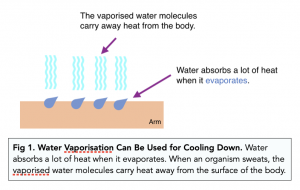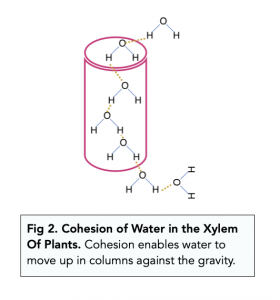Properties of Water (A-level Biology)
Water as a Metabolite
- Metabolic reactions keep living organisms alive.
-
- A metabolic reaction is a biochemical reaction that takes place in living organisms in order to keep them alive.
- A metabolite is a molecule that takes part in a metabolic reaction.
-
- Water is a very important metabolite. It is often a reactant necessary to start a metabolic reaction and is also often a byproduct of metabolic reactions.
- Water is a key metabolite in condensation and hydrolysis reactions. As we have seen numerous times so far already (e.g. condensation to make polymers such as polysaccharides and polypeptides).
Water as a Solvent
- Many important biological molecules are either polar molecules or ionic molecules. This means these molecules have some degree of electrical charge to them. In order for these molecules to function, they need to be dissolved in a polar solvent. Polar molecules cannot dissolve in non-polar solvents.
- Water is a key solvent for many biological molecules. Water’s polarity makes it a very good polar solvent for many biological molecules. For example, in ionic calcium chloride, the positive Ca2+ will be attracted to the negative pole of a water molecule, and Cl- will be attracted to the positive pole. Many metabolic reactions occur in water.
Latent Heat Capacity of Water
- Most organisms require a specific temperature range in order for them to survive. Drastic changes in temperature can often be lethal, especially to very small organisms.

- Water has a high latent heat capacity. The strength of the hydrogen bonds in water means that water has a high latent heat capacity. In order to vaporise water, these hydrogen bonds need to be broken, which requires quite a lot of energy.
- Water vaporisation can be used for cooling down. Water uses up a lot of heat when it evaporates, which is useful for many organisms because they can use water vaporisation as a thermoregulatory mechanism. When organisms sweat or transpire (sweating in plants), the vaporised water molecules carry away heat from the body.
- The organism can cool itself without losing too much water. However, because of the high latent heat capacity of water, the organism can cool itself down without losing too much water.

Cohesion
Cohesion is defined as the attraction between the same type of molecule.
- Water molecules have strong cohesion. Water molecules are attracted to each other because of hydrogen bonds and are thus very cohesive.
- Cohesion enables water to flow and transport. This strong cohesive property of water is what allows water to flow, which is very important for transporting substances in many organisms. For example, in the xylem of plants, cohesion enables water to move up in columns against the force of gravity.
- Cohesion produces surface tension where water meets air. Small organisms use this to walk on water.
Specific Heat Capacity of Water
Specific heat capacity of water is the amount of heat energy (J) needed to raise the temperature of 1kg of water by 1 kelvin.
- Water has a high specific heat capacity. This means that a lot of energy is needed to change the temperature of water, so water has a reasonably constant temperature.
- The ocean is a thermally stable habitat. There is little temperature fluctuation in large volumes of water (e.g. oceans and lakes). This means that aquatic creatures can live in a stable environment, making water an ideal habitat for many organisms.
Density and Incompressibility
- Maximum density of water is at 4°C. Water is most dense at 4°C at which point it is still a liquid. This means that when water freezes into ice, it becomes less dense. This is due to the fact that water molecules are held further apart in ice than water. Thus, ice floats, creating a layer of insulation so that the rest of the water below does not freeze. This allows aquatic organisms to continue living in that environment, hence another reason why water is an ideal habitat.
- Water is incompressible. Water is (for the most part) incompressible, meaning it cannot be squashed under normal conditions. For example, if you fill a balloon with water and try to completely squash it, the balloon would burst rather than yield under your pressure. This is due to the strong intermolecular bonds between the water molecules.
FAQs
Water is a unique and essential substance that has a number of important properties, including:
High heat capacity: Water has a high heat capacity, which means it can absorb and store a large amount of heat energy without a significant increase in temperature. This property helps to moderate temperature changes in the environment and makes water an effective coolant in biological systems.
High surface tension: Water has a high surface tension, which is due to the cohesive forces between water molecules. This property enables water to form a meniscus and allows insects and other small organisms to walk on water.
High boiling point and melting point: Water has a high boiling point and melting point compared to other substances of similar molecular weight. This is due to the extensive network of hydrogen bonds between water molecules.
Good solvent: Water is an excellent solvent for polar and ionic substances. This property allows it to dissolve a wide range of compounds, making it an essential medium for many biological and chemical reactions.
High density: Water has a high density in its liquid form, which means it can provide buoyancy and support to organisms living in water.
Unique solid form: Water has a unique solid form, in which the hydrogen bonds between water molecules form a crystal lattice structure that is less dense than liquid water. This property causes ice to float on water and provides insulation for aquatic organisms during the winter months.
Ionization: Water can ionize to form H+ and OH- ions, which are important in many chemical and biological reactions.
Water is a unique substance that has several properties that make it essential for life. These properties include: high boiling and melting points, high specific heat, high surface tension, and the ability to dissolve many substances. These properties allow water to regulate temperature, transport nutrients, and provide a suitable environment for biological processes to occur.
The three properties of water that are relevant to A-Level Biology are:
Cohesion and surface tension: Water molecules are cohesive and tend to stick together due to hydrogen bonding. This gives water a high surface tension, which allows insects to walk on water and helps plants to transport water from roots to leaves.
High specific heat capacity: Water has a high specific heat capacity, which means that it can absorb or release large amounts of heat energy without changing temperature significantly. This makes water an excellent temperature buffer, helping to regulate temperature in living organisms and environments.
Solvent properties: Water is a polar molecule, which means that it can dissolve other polar molecules and ions. This makes water an excellent solvent for many biological molecules, such as sugars, amino acids, and salts. It also helps to transport nutrients and wastes in living organisms.
Water specific heat capacity refers to the amount of heat energy required to raise the temperature of one gram of water by one degree Celsius. The specific heat capacity of water is relatively high compared to other substances, meaning that it can absorb and store a large amount of heat energy without a significant increase in temperature.
The specific heat capacity of water is 4.184 joules per gram per degree Celsius (J/g°C) at 25°C, which means that it takes 4.184 joules of energy to raise the temperature of one gram of water by one degree Celsius. This high specific heat capacity makes water an effective coolant in biological systems, as it can absorb and dissipate heat energy generated by metabolic processes and maintain a stable internal temperature.
The high specific heat capacity of water is also important in climate regulation, as the oceans act as a heat sink, absorbing and storing large amounts of heat energy from the sun and the atmosphere. This helps to moderate temperature changes in the environment and contributes to the stability of the Earth’s climate.
The latent heat capacity of water is the amount of heat energy required to change the phase of water without changing its temperature. There are two types of latent heat capacities of water:
Latent heat of fusion: This is the amount of heat energy required to change one gram of solid water (ice) at 0°C to liquid water at 0°C. The latent heat of fusion of water is 334 J/g.
Latent heat of vaporization: This is the amount of heat energy required to change one gram of liquid water at 100°C to water vapor (steam) at 100°C. The latent heat of vaporization of water is 2260 J/g.
These values are relatively high compared to other substances, which means that water has a high capacity for storing and releasing heat energy during phase changes. This property of water is important for regulating temperature in living organisms and environments, as water can absorb or release large amounts of heat energy without changing temperature significantly.
Cohesion is the property of water molecules that allows them to stick together due to hydrogen bonding. Water molecules are polar, which means they have a partial negative charge on one end (the oxygen atom) and a partial positive charge on the other end (the hydrogen atoms). The positive hydrogen end of one water molecule is attracted to the negative oxygen end of another water molecule, creating a hydrogen bond between them.
This hydrogen bonding between water molecules gives water its high cohesion, which is the tendency of water molecules to stick together and form a continuous surface. Cohesion allows water to form droplets and to flow as a liquid, rather than breaking up into separate molecules. Cohesion also contributes to the surface tension of water, which is the elastic-like property that allows insects to walk on water and some plants to float on water.
Cohesion is an important property of water that helps to support life. It plays a role in the transport of water and nutrients in plants, and it contributes to the function of the cardiovascular system in animals by helping blood to flow through narrow vessels.
Water’s high specific heat means that it can absorb a large amount of heat without a significant increase in temperature. This property allows water to act as a thermal buffer, helping to regulate the temperature of living organisms and the environment. This is particularly important for aquatic organisms, which rely on the water to maintain a stable temperature range for their metabolic processes.
Water’s ability to dissolve many substances, including salts, sugars, and other organic molecules, makes it an ideal medium for biological processes. This property allows nutrients and other essential compounds to be transported throughout the body and helps to facilitate chemical reactions that are necessary for life.
Water plays a crucial role in maintaining homeostasis in living organisms. It helps to regulate body temperature, transport nutrients, and facilitate chemical reactions. Additionally, water helps to balance the levels of various ions and other substances in the body, which is essential for normal physiological processes to occur. By maintaining a stable internal environment, water helps to ensure the survival and health of living organisms.
Water is an important metabolite because it plays a crucial role in many metabolic processes that occur within living organisms. Some of the reasons why water is essential for metabolism are:
Water is a solvent: Water’s solvent properties allow it to dissolve and transport many biological molecules, such as carbohydrates, proteins, and nucleic acids. This allows these molecules to interact and undergo reactions that are necessary for metabolism.
Water is a reactant: Many metabolic reactions, such as hydrolysis and condensation reactions, require water as a reactant or product. Water participates in these reactions and helps to break down or build up biological molecules.
Water regulates temperature: Water has a high specific heat capacity, which means that it can absorb or release large amounts of heat energy without changing temperature significantly. This property helps to regulate temperature in living organisms and ensures that metabolic reactions occur at optimal temperatures.
Water is a source of hydrogen ions: Water molecules can be ionized to form hydrogen ions (H+) and hydroxide ions (OH-). These ions are important for many metabolic processes, including enzyme catalysis and pH regulation.
Water participates in photosynthesis: In photosynthesis, water is oxidized to form oxygen gas and to provide electrons for the production of ATP and NADPH, which are used in the synthesis of carbohydrates.






Still got a question? Leave a comment
Leave a comment